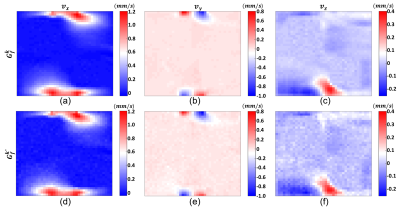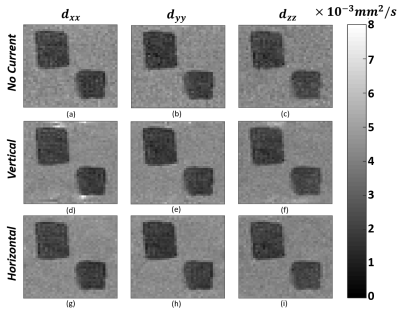Mert Şişman1, Mehdi Sadighi1, and B. Murat Eyüboğlu1
1Electrical and Electronics Engineering, Middle East Technical University (METU), Ankara, Turkey
1Electrical and Electronics Engineering, Middle East Technical University (METU), Ankara, Turkey
In
this study, it is shown that the magnetohydrodynamic (MHD) flow velocity and
diffusion tensor images can be obtained from the same acquisition with careful
selection of the flow-encoding gradients. The experimental results demonstrate validity
of this claim.

Figure
3: MHD flow velocity distributions of the experimental phantom with vertical
current injection. Using the conventional flow-encoding set ($$$\mathbf{{G_f^k}}$$$): (a) vx, (b) vy, and (c) vz; and using the proposed
flow-encoding set ($$$\mathbf{{G_f^k}^*}$$$): (d) vx, (e) vy, and (f) vz. The $$$RMSE(\%)$$$ values in each direction: $$$RMSE_x=2.17\%$$$,
$$$RMSE_y=2.80\%$$$,
and $$$RMSE_z=1.66\%$$$.

Figure 5: Diffusion tensor images obtained from simultaneous DTI and MHD
imaging. $$$\overline{\overline{D}}$$$ distributions
obtained without current injection: (a) dxx, (b) dyy, and (c) dzz; with
vertical current injection: (d) dxx, (e) dyy, and (f) dzz; and with horizontal current injection: (g) dxx, (h) dyy, and (i) dzz. $$$\overline{\overline{D}}$$$ images obtained with current injections have $$$\sqrt2$$$ SNR advantage.